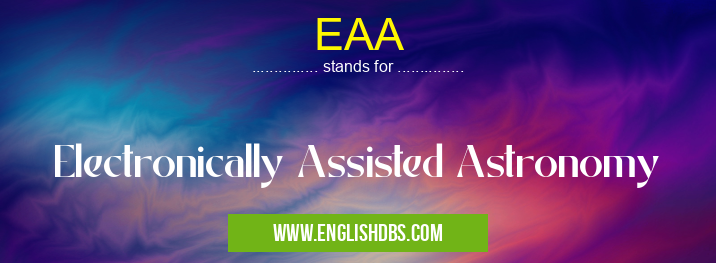What does EAA mean in ASTRONOMY
EAA (Electronically Assisted Astronomy) is a rapidly growing field that combines the latest electronic technologies with traditional astronomical techniques. It allows astronomers to observe the night sky in ways that were previously impossible, leading to new discoveries and a deeper understanding of the universe.

EAA meaning in Astronomy in Academic & Science
EAA mostly used in an acronym Astronomy in Category Academic & Science that means Electronically Assisted Astronomy
Shorthand: EAA,
Full Form: Electronically Assisted Astronomy
For more information of "Electronically Assisted Astronomy", see the section below.
What does EAA Stand for?
EAA stands for Electronically Assisted Astronomy, which refers to the use of electronic devices to enhance astronomical observations.
Key Features of EAA
- Digital Imaging: EAA uses digital cameras to capture images of celestial objects. These images can be processed and analyzed using software to reveal details and features that are not visible to the naked eye.
- Spectroscopy: EAA allows astronomers to study the light emitted by celestial objects, revealing information about their composition, temperature, and velocity.
- Photometry: EAA measures the brightness of celestial objects, enabling astronomers to track changes over time and study their variability.
- Astrometry: EAA techniques can be used to accurately measure the positions and movements of celestial objects.
Benefits of EAA
- Increased Sensitivity: Electronic devices can detect faint light, allowing astronomers to observe objects that are too dim for the naked eye.
- Objective Data Collection: Electronic devices provide precise and objective data, eliminating human biases and reducing errors.
- Enhanced Resolution: Digital imaging and spectroscopy enable astronomers to achieve high-resolution images and spectra.
- Automation: EAA systems can be automated, allowing astronomers to collect data over long periods of time without manual intervention.
Applications of EAA
EAA techniques are widely used in various fields of astronomy, including:
- Deep-sky Observing: EAA allows astronomers to explore faint galaxies, nebulae, and star clusters.
- Exoplanet Detection: EAA techniques are used to detect and characterize exoplanets orbiting distant stars.
- Astrophysics: EAA provides data for studying stellar evolution, black holes, and other astrophysical phenomena.
- Education and Outreach: EAA tools make astronomy more accessible and engaging for students and the general public.
Essential Questions and Answers on Electronically Assisted Astronomy in "SCIENCE»ASTRO"
What is Electronically Assisted Astronomy (EAA)?
Electronically Assisted Astronomy (EAA) is a modern approach to astronomy that utilizes electronic devices to enhance the observing experience. It involves using computers, cameras, and specialized software to capture, process, and analyze astronomical data, making it more accessible and enjoyable for amateur astronomers.
What are the benefits of EAA?
EAA offers numerous benefits, including: Enhanced image quality and detail, enabling users to capture faint objects and observe celestial events more clearly. Automated tracking systems, which keep telescopes aligned with targets, reducing manual adjustments and improving observation efficiency. Real-time data analysis and processing, allowing astronomers to instantly interpret their observations and make informed decisions. Increased accessibility, as EAA equipment can be used from urban areas or remote locations where light pollution may be an issue.
What types of electronic devices are commonly used in EAA?
Common EAA devices include: CCD (Charge-Coupled Device) and CMOS (Complementary Metal-Oxide-Semiconductor) cameras, which capture light and convert it into digital data. Computers and laptops, which run specialized software for image processing, analysis, and telescope control. Autoguiders, which assist in keeping telescopes accurately pointed at targets. Filter wheels, which allow users to swap between different filters to enhance specific wavelengths of light.
How can I get started with EAA?
To get started with EAA, consider the following steps: Obtain a compatible telescope and mount that can accommodate electronic accessories. Acquire an astronomy camera (CCD or CMOS) and necessary software. Learn basic image processing techniques to enhance your captured data. Join astronomy forums and online communities to connect with experienced EAA enthusiasts.
What are some popular EAA software programs? A: Several software programs are widely used in EA
Several software programs are widely used in EAA: AstroImageJ: Open-source software for image processing, analysis, and photometry. MaximDL: Commercial software offering comprehensive features for telescope control, image acquisition, and processing. SharpCap: Freeware for live viewing, image capture, and basic processing. PHD2: Open-source autoguiding software designed for accurate telescope tracking.
Final Words: EAA has revolutionized astronomy by providing astronomers with powerful tools for observing the night sky. It has led to significant advancements in our understanding of the universe and continues to be a driving force for scientific discovery.
EAA also stands for: |
|
| All stands for EAA |
